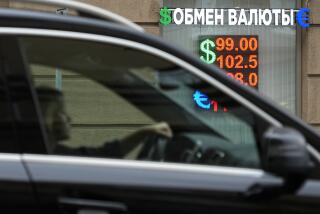Soviets Will Open Domestic Money Exchanges : Transactions: The surprise move will enable businesses with no export potential to buy hard currency for equipment purchases abroad.
- Share via
MOSCOW — The Soviet Union announced Tuesday that it would introduce domestic money exchanges next year where the ruble, battered by a growing black market, would trade freely against other currencies.
A government statement said the decision, effective Jan. 1, was an integral part of the coming switch from a planned to a market economy and would help prepare the ground for eventual ruble convertibility.
The statement said a previously unannounced government decree dated Aug. 4 provided for the opening of exchanges in Moscow, the capitals of the 15 Soviet republics and in other major cities.
It was not immediately clear how far foreign organizations would be able to take part in dealing on the exchanges, but a Finance Ministry official said he saw no obstacle to non-Soviet banks joining in.
The official, who asked not to be identified, said the main purpose of the exchanges would be “to enable Soviet enterprises and organizations who have no export potential to buy currency to purchase equipment abroad for their own development.”
Many Soviet businesses, gaining increasing independence under President Mikhail S. Gorbachev’s economic reforms, hold vast sums of rubles but have no access to foreign currency because they produce only for the domestic market.
During the past year, the state Bank for Foreign Economic Relations (Vneshekonombank) has held occasional currency auctions for Soviet organizations, but newly emerging commercial banks are known to be keen to take part in these operations.
The Finance Ministry official said the exchanges, likely to be open at least twice a week, were an extension of auctions held once a month in which only Soviet organizations have been allowed to participate.
One Western banker in Moscow said there would be a clear interest for foreign sellers to act on the new exchanges despite the limited demand for the ruble, which has not been freely traded in the outside world since the 1920s.
But the Finance Ministry official said there was no question at this stage of allowing export of rubles, at present strictly banned, for sale abroad to raise hard currency. “These will be purely domestic markets,” he said.
The statement said Gosbank would control interbank and all other operations at the new exchanges, which would be the first in the Soviet Union for six decades.
The assertion that the measure was a move toward convertibility, or free exchange of the ruble on world markets, surprised Soviet economists and foreign bankers.
Even Soviet government experts have said frequently that this was unlikely to be achieved before the mid-1990s at the earliest, even if the long-delayed switch to a market system brings a quick boost to the crumbling economy.
The ruble has two officially set exchange rates--a trading one of 0.58 against the dollar and a tourist rate of 5.8 to the dollar. But on the black market, Soviet business publications say, the dollar sells for up to 25 rubles.
Soviet officials admit that the official rate, calculated against a basket of Western currencies and at which all official foreign transactions are carried out, is grossly out of line with the ruble’s real value.
It has been widely assumed by foreign and Soviet specialists that the ruble could not be freely traded on world markets without devastating effects on the already weak economy before radical economic reforms took hold.
The government announcement did not make clear exactly how far the ruble would be exposed.
It is now being rapidly replaced in domestic trade by barter and even the dollar amid widespread shortages of many goods.
More to Read
Sign up for Essential California
The most important California stories and recommendations in your inbox every morning.
You may occasionally receive promotional content from the Los Angeles Times.













